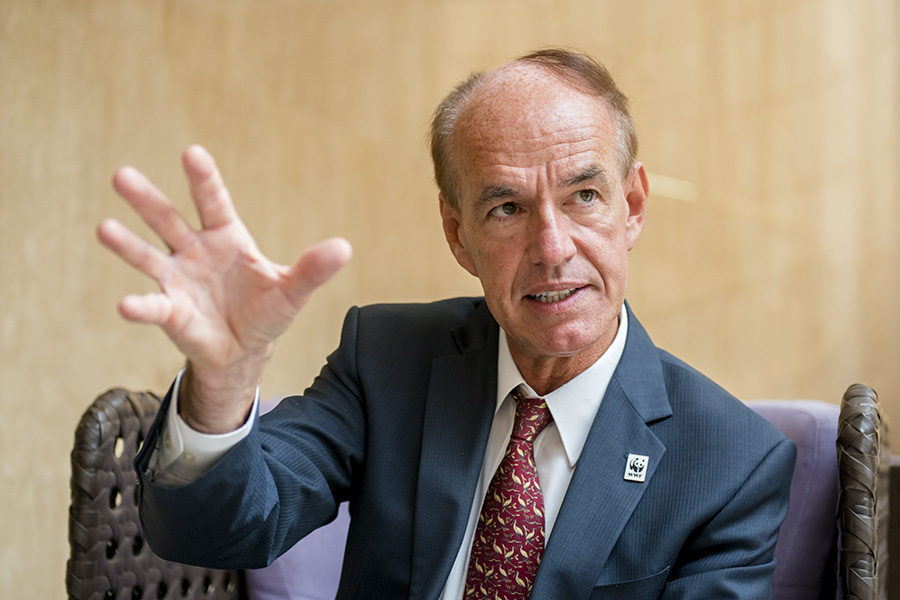Marco Lambertini: Riding the Green Silk Road

Early on the morning of May 14, local residents rode variously-colored shared bikes in groups of two and three near the National Convention Center in northern Beijing where the Belt and Road Forum for International Cooperation was being hosted. Thanks to the mobile internet and GPS, such transport tools have become increasingly popular in China, as it shifts to a greener economy.
Hours later at the venue, Chinese President Xi Jinping outlined his ambitions for green development under a global spotlight as he addressed 29 foreign state leaders along with some 1,500 delegates from over 130 countries—mostly entrepreneurs, financiers, officials and scholars.
“We should pursue a new vision for green development and a way of living and working that is green, low-carbon, circular and sustainable,” Xi said. Seated in the audience, Marco Lambertini, director general of World Wide Fund for Nature (WWF) International, strongly endorsed the new proposals for development.
“The Belt and Road Initiative has two key dimensions,” Lambertini explained. “One is a new form of collaboration across countries, not to be competitive but for win-win situations. The other is sustainable development: to develop in an equitable way in which everybody benefits and doesn’t hurt the environment.”
Determined to transform shared vision into joint action, Xi proposed the establishment of an international coalition for green development along the Belt and Road. He also announced a plan to set up a big data service platform for ecological and environmental protection.
Lambertini considers this a sensible approach because currently available information has not yet been utilized, and thinks that such a platform would aid the designers and planners of Belt and Road projects. The WWF has assisted many governments and companies in information collection and environmental assessment as well as offering advice on sustainable development.
“About 50 or 60 years ago, all of the developed world, including Europe, experienced the same pollution that China does today,” Lambertini continued. “In China, it is a more acute problem because it is happening faster, more concentrated and more intensely, but the basic problem is the same—developing the economy at the expense of environment.”
“We always expect nature to be invincible and resilient, but it can be very fragile. The more you hurt the planet, the more the planet hurts back.” He regards current suffering from air pollution as a visible face of climate change, demonstrating its existential threat to human beings.
“Do not make environmental consideration an after-thought,” stresses Lambertini. “We need to consider it at the planning stage.” He believes that a shift in mindset is critical to changing modes of development.
“The Belt and Road Initiative generates enormous opportunities to stimulate governments in emerging economies to leap over the damage seen in past decades,” he added. “Chinese companies should apply the tactics they developed in China to make the Chinese economy greener to the countries along the Belt and Road to help them avoid the pains that Europe, the United States and China once endured.”

With 25 years of global conservation leadership, Marco Lambertini began his association with WWF as a volunteer in his native Italy. by Guo Shasha
Lambertini rejoices that countries along the Belt and Road are embracing renewable energy as well as China’s leading role. At the forum, Xi stressed the need to seize opportunities brought by shifts in energy sources and the revolution in energy technologies, to develop global energy interconnection and achieve green and low-carbon development.
“President Xi is very committed,” Lambertini said. “He is driving the green revolution in the country. China is now the global leader in renewable energy and the single most important market.”
In China’s development plan for 2016 to 2020, 2.5 trillion yuan (US$363 billion) will flow into renewable energy development, creating 13 million new jobs or more. Annual usage of commercialized renewable energy in China, including water, wind, solar, biomass and geothermic power, will hit an equivalent of 580 million tons of standard coal by 2020, sharply cutting greenhouse gases emissions.
Aside from being a firm advocate for renewable energy, WWF is also involved in connecting local communities, governments and businesses in the countries along the Belt and Road thanks to its extensive local offices that give it an acute advantage in addressing environmental concerns related to infrastructure construction.
Lambertini was impressed that the China Road and Bridge Corporation raised bridge pillars tall enough to allow wild giraffes to walk under when building the Mombasa-Nairobi railway in Kenya.
“As environmental awareness has risen, Chinese companies have proved that infrastructure construction can be environmentally friendly,” he said.
The Belt and Road Initiative has made considerable progress in facility connectivity since it was first launched four years ago. Infrastructure projects are expected to increase after Xi announced at the forum that China plans to augment the Silk Road Fund with 100 billion yuan (about US$14.5 billion) and the equivalent of 380 billion yuan in loans for infrastructure and development projects from Chinese policy banks, a vital move to narrow regional financing gaps.
Lambertini appreciates that financial institutions including the Silk Road Fund and the Asian Infrastructure Investment Bank have incorporated green finance principles. He notes that the real challenge is monitoring implementation of the green finance system.
“It is not an easy task to audit every company applying for funds.” He suggests considering all of the impact the construction will have on environment, both on the site and beyond.
The two-day forum charted the course for the Belt and Road Initiative with a joint communiqué of state leaders and a long list of major deliverables, in which sustainable development is underlined. As Lambertini stresses, the greener way is future.
